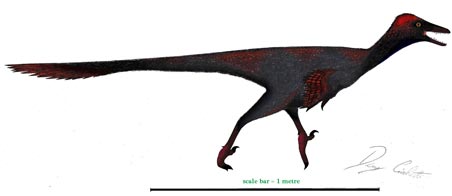Gobivenator mongoliensis – A New Troodontid from the Central Gobi Desert
A new scientific paper has just been published by an international team of scientists including researchers from Tokyo University that details the discovery of a troodontid dinosaur. Troodonts are a group of small theropod dinosaurs that seem to lie somewhere between those speedy, long-legged ornithomimids such as Gallimimus and the fearsome dromaeosaurids such as Velociraptor.
New Troodontid Dinosaur
Fossils of these little dinosaurs (most of them were around two metres in length, most of that being tail), have been found in Upper Cretaceous deposits of North America and Asia. From the several near complete specimens of this family known, palaeontologists have identified that their skeletons were very bird like and that these animals in proportion to the rest of their bodies, had relatively large brains for a member of the Dinosauria.
The newest member of the Troodontidae has been named Gobivenator mongoliensis (the name means “Gobi desert hunter from Mongolia”). The almost complete specimen, including a very well preserved skull which was just missing the tip of the snout was excavated from deposits in the Djadokhta Formation of the central Gobi desert region. Post cranial material includes virtually the rest of the skeleton with just some smaller bones and a neck vertebra (cervical vertebrae) missing. A number of important Late Cretaceous fossils representing oviraptorids, dromaeosaurids, tyrannosaurs, as well as ornithischian dinosaurs, mammals, lizards and crocodiles have been found in the strata that makes up the Djadokhta Formation.
Gobivenator mongoliensis
Perhaps the most famous part of the Formation is the famous “Flaming Cliffs” , named for the reddish colour of the sandstones, as explored by the American Museum of Natural History expeditions led by Dr Roy Chapman Andrews.
The sandstone deposits of the Djadokhta Formation preserve evidence of a semi-arid, desert environment that had a number of oasis spread across it. The fossils of Gobivenator have been dated to around 72 million years ago, although the exact date range of the entire Formation remains debated. Most of the strata does date from the Early Maastrichtian/Campanian, but there is some evidence to suggest that the earliest deposits, representing a slightly more humid and wet environment date from the Santonian faunal stage.
Measuring around 1.6 metres in length (half of the body length being made up of the long tail) and most probably feathered, Gobivenator was probably a hunter of small, lizards, baby dinosaurs and mammals. It may have lived in social packs.
An Illustration of Gobivenator mongoliensis
Picture credit: Danny Cicchetti
The Newest Member of the Troodontidae
The near complete skeleton and the very well preserved and undistorted skull has provided the joint Japanese/Mongolian scientists with a unique opportunity to explore the phylogenetic relationship between members of the Troodontidae and also between troodonts and Aves (birds). The shape and structure of the palate has been determined, showing close affinities with dromaeosaurids such as Velociraptor and primitive birds.
For articulated models of troodontids and dromaeosaurids: Beasts of the Mesozoic Articulated Dinosaur Figures.
Although the skull of Gobivenator is strongly fused (akinetic – limited movement between bones), it already shows preconditions for the later evolution of a more flexible skull as seen in many types of modern bird (cranial kinesis). Preconditions identified by the research team include reduced contact between the small bones that make up the palate and the absence of a slender epipterygoid bone.
Cranial kinesis is effectively the ability of skull bones to flex against each other. This adaptation is most closely allied to the need to cope with awkward or difficult to swallow prey items. A number of bird families show a degree of cranial kinesis, most notably Prokinesis (flexing of the front facing portions of the skull). In modern Aves, it is the psittacine (parrots) family that show the most pronounced form of cranial kinesis. It is thought that the skull flexing in members of the parrot family evolved to help them feed on large, robust nuts and fruit.
The scientific paper detailing this research has been published in the academic journal “Naturwissenschaften” – the science of nature.






Leave A Comment